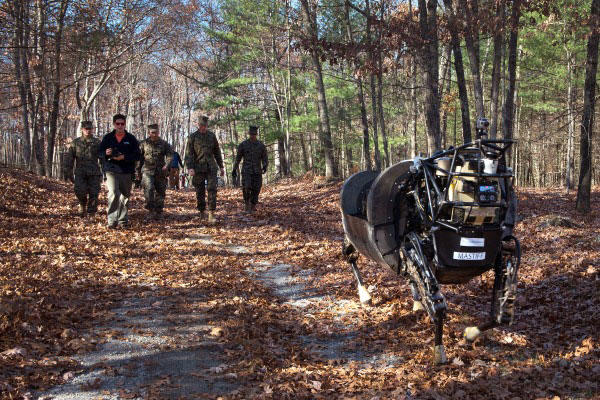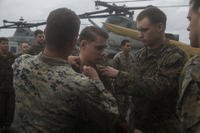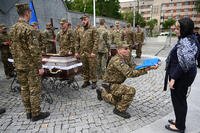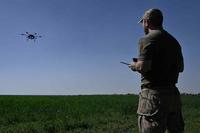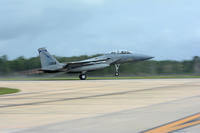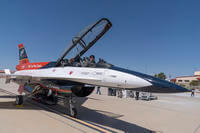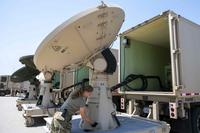The chiefs of the military's unmanned systems departments see a near future in which robots operate side-by-side with ground-pounders downrange. And they already foresee their biggest challenge: establishing an emotional bond of trust between man and machine.
Deputy Assistant Secretary of the Navy for Unmanned Systems Frank Kelley said Marines might someday bond with their unmanned systems the way today they bond with and trust their military working dogs.
"Someday we may be able to replace that image of the Marine and the dog with an unmanned system," he said at the Sea Air Space expo near Washington, D.C. "We need to be prepared with these relationships, with these warfighting relationships, relationships with Marines and sailors and machines alongside."
At the Marine Corps Warfighting Lab in Quantico, Virginia, officials are testing out a system that might inspire those kind of close man-machine relationships.
The lab tested out Unmanned Tactical Autonomous Control and Collaboration, in late April by employing a team of air and ground robots with data sharing and artificial intelligence capabilities to provide intelligence and reconnaissance to squad-level units.
With decision-making power and the ability to learn preferences, some of the machines may be advanced enough to make Marines forget they're not dealing with another individual, suggested Col. James Jenkins, the director of the Warfighting Lab's Science and Technology division.
"The emotional bond will be different. In [Dr. Peter Singer's] book Wired for War, he talks about guys using [improvised explosive device removal robots]; literally, they're like dogs or almost kids to them and they're crying when a machine gets blown up," Jenkins told Military.com. "Does that happen for a drone? No, probably not."
Communication and trust make the difference, he said.
"As you start to envision a machine where you go, 'Hey, I want you to screen my flank and tell me if you see any armored vehicles or groups of people more than 30, boom, go," Jenkins said.
"And over time, the machine is learning what I'm looking for," he added, "and it acts to me just like a lance corporal or a captain on the other end of the radio, then you do start to get that bond and that trust."
Specific machines now undergoing testing at the lab include Spot, a quadruped that can take commands and execute them, but struggles to react to changing situations, and Gus, an unmanned vehicle that can carry gear to troops in the field, but need operator input at the beginning and end.
Right now, the questionable reliability of unmanned prototypes and their need for extensive supervision -- what Jenkins called the "irony of automation," can prevent Marines from getting close to their robotic counterparts.
"At the end of the day, what we found is when the bullets start flying, the Marine either becomes so absorbed in driving the robot that he loses essay of what's happening around him, or he drops the controller and becomes a rifleman," Jenkins said.
While the systems do have to get better and more reliable, Jenkins also said Marines need more exposure to them on a regular basis so they can understand how they work and their strengths and limitations.
"These things have to be small, smart, and cheap, because I have to be with them every day," he said. "It can't be this boutique item I roll out once a year and interface with; I've got to be constantly working with it."
The Marine Corps' assistant deputy commandant for Installations and Logistics, plans, Maj. Gen. Vince Coglianese, said he wanted to see the Marine Corps take a note from industry and conduct training in which robots and humans executed tasks side-by-side, and then switched tasks, so troops could understand what the robots had to offer.'
In a not-too-distant future, Coglianese cautioned, Marines may have to take care not to turn too much decision-making power over to capable unmanned systems that nonetheless lacked the human instincts and experience that their human counterparts had.
"The human brain is pretty adaptable," he said. "If you take it out of the decision making, you might be making the wrong decision."
-- Hope Hodge Seck can be reached at hope.seck@military.com. Follow her on Twitter at @HopeSeck.
